According to the research on the warehousing market, it can be found that in order to increase the storage capacity of the warehouse, many enterprise customers generally require narrow aisle (VNA) shelves in the design, planning and construction of the warehouse. You will be told that if you want to plan narrow aisle (VNA) racking, you must first deal with the ground problem of the warehouse.

So the question is, why do narrow aisle (VNA) shelves have such high requirements on the warehouse floor? Based on most of the customer project cases it has cooperated with and the installation and construction experience of narrow aisle (VNA) shelves, Hebei Herglis storage shelves have analyzed this problem one by one, and arranged them as follows, so that customers who use storage shelves can understand.

Why is it so important to have a good floor for narrow aisle warehouses?
The narrow-aisle warehouse is mainly composed of the house floor, narrow-aisle forklifts, shelves, and guide rails in the aisle. For narrow-aisle vehicles, good ground is not only a prerequisite for safe operation, but also for specified operations using narrow aisles. At the same time, the user’s demand for these main components of narrow aisle (VNA) racking warehouses is increasing, which is related to higher requirements for operational performance and lifting height.Electric narrow-aisle vehicles and storage materials are often able to meet specifications because they are manufactured in the factory to the standard used. Casting concrete floors is relatively more difficult, and there is a limited amount of time to work on concrete floors before they start to harden, making it much more difficult to keep them strictly flat and uniform. If the ground is slightly uneven, it means that the narrow-aisle vehicle will tilt when driving, that is to say, the upper part of the narrow-aisle vehicle will be statically inclined or displaced in the longitudinal direction. When the ground of a warehouse does not meet the measurement and planning standards, there are more or less indentations or ground seams, which will cause unnecessary collisions between operators, goods, electric trucks, etc., so that these The phenomenon area becomes larger and deeper, resulting in unnecessary narrow aisle (VNA) shelving.
At the same time, narrow aisle (VNA) racking planning also mainly depends on two factors: one is the flatness of the ground. Because the narrow aisle (VNA) fork and the operating room are raised to work at high altitudes, if the two sides of the wheels are not smooth, Dangerous to operation. For example, the ground height of the two wheels differs by 5mm. After the forklift lifts to the high altitude, the forklift tilts to one side to 50nmm. If the two goods are not stacked neatly, if they touch the goods, the stacker can walk at 20km/h. This is more dangerous.
The second is the amount of ground subsidence: because the foundation is a soft foundation, it will cause natural subsidence for a year or a few years, and it will also cause the ground to be uneven. In addition, there is a support block at the bottom of the narrow roadway (VNA) forklift. In order to ensure that the forklift will not tip over, the gap between this support block and the ground is about 15mm. If the ground is uneven, it will rub against the ground.
Post time: May-09-2022



